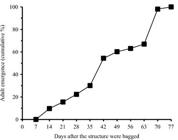Abstract:
The objective of this work was to determine the survival pattern of the cotton boll weevil during fallow in Midwestern Brazil. The percentage of adults that remained in the cotton reproductive structures, the percentage of adults searching for shelters, and the longevity of adults fed on pollen and nectar as alternative food sources were determined. For this, four populations were sampled in cotton squares and bolls, totaling 11,293 structures, from 2008 to 2012. The emergency of cotton weevil adults was monitored from the collection of the structures until the next cotton season. In the laboratory, newly-emerged adults were fed on hibiscus or Spanish needle, and their life span was monitored individually. Most adults (85.73%) left the reproductive structures, regardless of the cotton plant phenology, up to 49 days after the structures were collected. One individual (0.0002%) from 5,544 adults was found alive after the fallow period. The diet with hibiscus and Spanish needle provided adult longevity of 76±38 days, which was enough time for adults to survive during the fallow period. Most of the boll weevils leave the cotton structures at the end of harvest, survive using alternative food sources, and do not use cotton plant structures as shelter during the legal cotton fallow period in Midwestern Brazil.
Index terms:
Anthonomus grandis; Gossypium hirsutum; alternative food; cotton bolls

 Thumbnail
Thumbnail
 Thumbnail
Thumbnail
 Thumbnail
Thumbnail
 Thumbnail
Thumbnail



